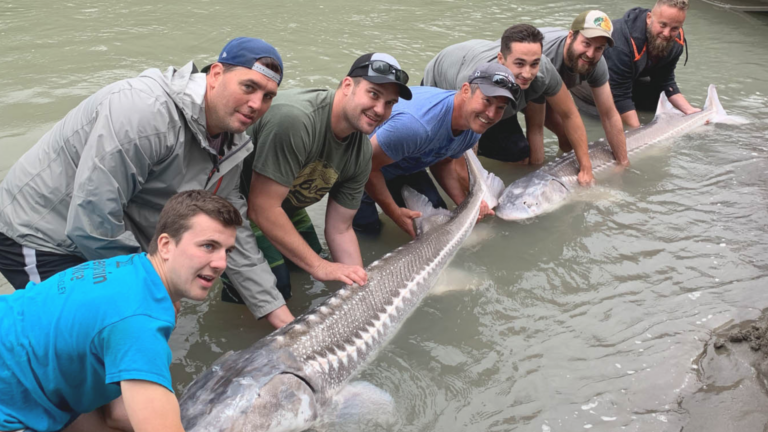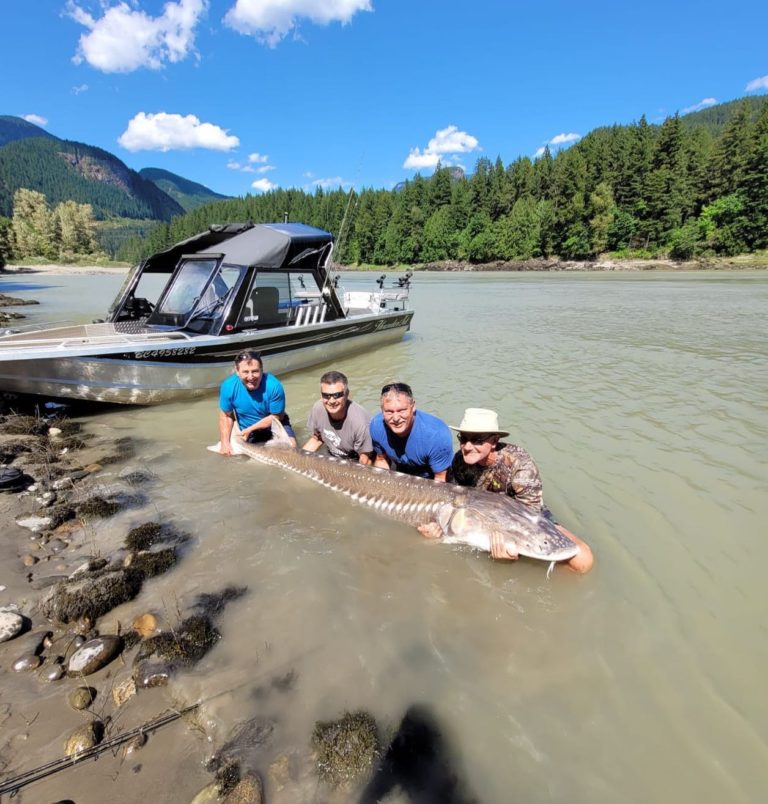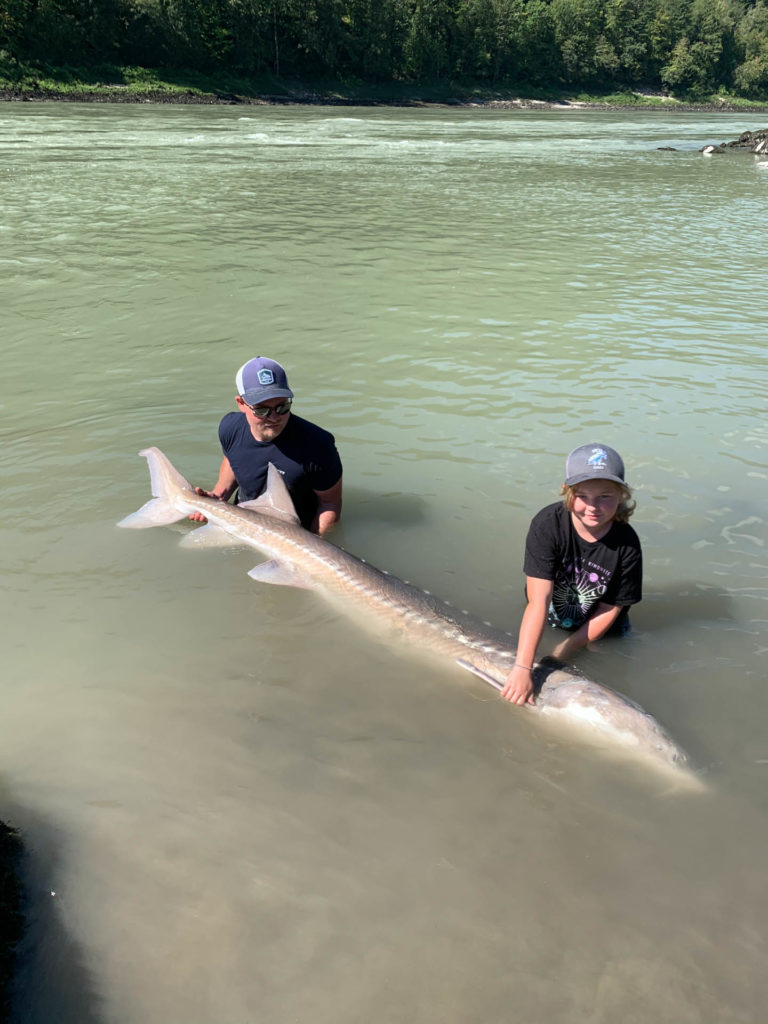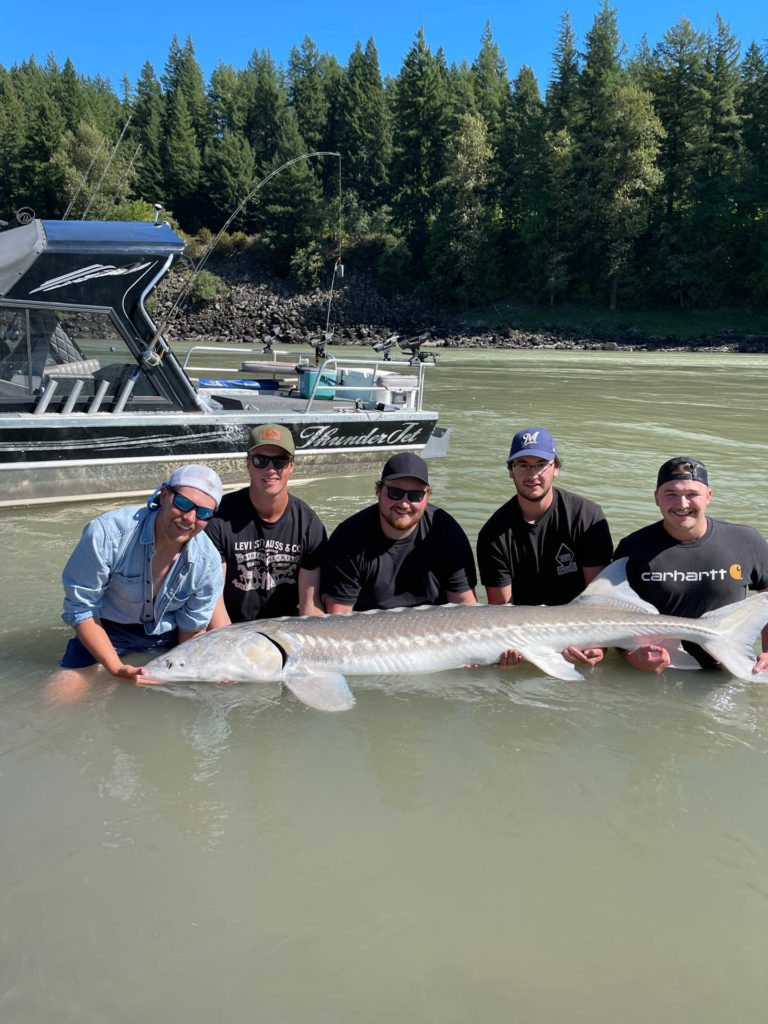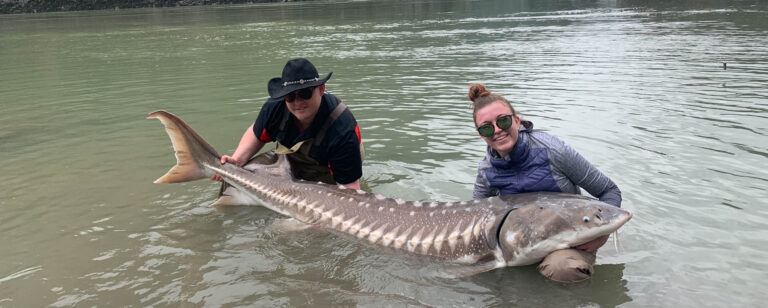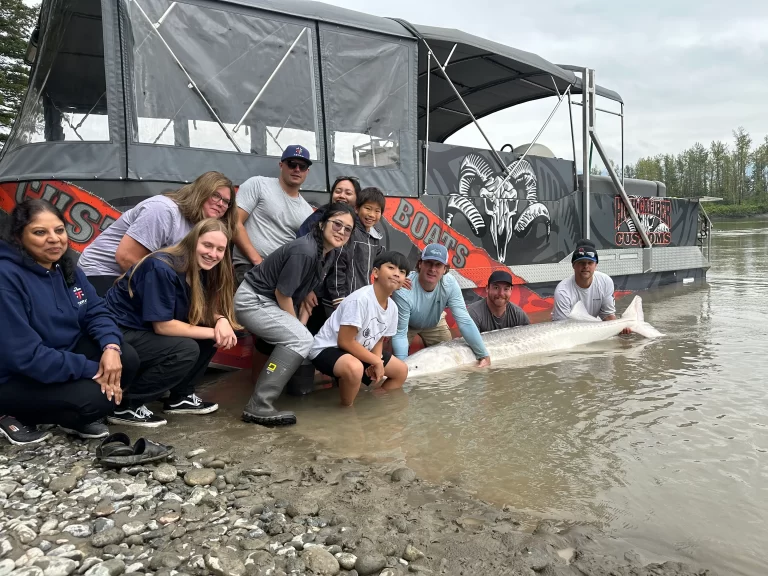Understanding Sturgeon Seasonality: How Water Temperature and Food Sources Affect Activity
Seasonal changes highly influence Fraser River sturgeon in water temperature, food availability, and river conditions. During colder months, their metabolism slows down, reducing activity, while warmer temperatures and seasonal fish migrations increase feeding behaviors.
The annual salmon run is one of the most significant factors affecting sturgeon activity. As salmon move through the Fraser River, they provide a high-protein food source, leading to some of the most intense feeding periods for sturgeon. Understanding these cycles can help anglers plan their trips for the most productive fishing days.
Data from the Fraser River Sturgeon Conservation Society (FRSCS) and Fisheries and Oceans Canada (DFO) have shown that sturgeon movement patterns vary significantly by season. This variation is influenced by factors such as water flow rates, seasonal flooding, and the presence of prey species like eulachon and lamprey.
Month-by-Month Breakdown: When to Plan Your Fraser River Sturgeon Fishing Trip
January – February: Cold Water, Deep Resting Areas
Sturgeons are the least active during winter, preferring deep holes where the water remains more stable. Anglers who fish during this period must use slow bait presentations and be prepared for fewer bites. Since the river conditions can be challenging, fishing during this time requires patience and persistence.
Best baits: Lamprey, salmon roe
Best locations: Deep wintering holes near Mission, Hope, and Chilliwack
March – April: Warming Waters and Pre-Spawn Feeding
As temperatures rise, sturgeon gradually become more active, moving into slightly shallower feeding areas. This is a great time to target transitional zones where sturgeon moves between winter-holding spots and spring feeding grounds. River conditions can fluctuate due to melting snow, so monitoring water flow is essential.
Best baits: Eulachon, fresh salmon eggs
Best locations: River bends and feeding zones near spawning areas
May – June: Increased Feeding Before Summer
With higher water temperatures, sturgeon metabolism speeds up, leading to more aggressive feeding behaviors. This period is excellent for testing different bait options and fishing locations. With rising water levels, anglers may need to adjust their weight setup to keep the bait in the optimal feeding zone.
Best baits: Fresh squid, lamprey, salmon roe
Best locations: Current breaks and deeper feeding pools
July – August: Peak Season for Aggressive Strikes
Summer is one of the best seasons for Fraser River sturgeon fishing. Warmer waters mean sturgeon actively feeds throughout the day, and fights are often more prolonged and intense. Due to high catch rates and ideal weather conditions, this is also one of the busiest times for guided fishing charters.
Best baits: Eulachon, fresh salmon roe, lamprey
Best locations: Deep current channels with strong food sources
September – October: The Ultimate Sturgeon Fishing Window
This is considered the best time of year to fish for sturgeon on the Fraser River. With salmon runs at their peak, sturgeon gorge themselves on high-protein food sources, making them more aggressive and more straightforward to target. This is the best period for catching trophy-sized white sturgeon, as they feed heavily in winter preparation.
Best baits: Fresh salmon roe, eulachon, squid
Best locations: Near spawning grounds and migration paths
November – December: Slowing Down but Still Rewarding
As winter approaches, sturgeon activity decreases, but dedicated anglers can still land big fish with the proper techniques. Using natural bait and fishing deeper waters can still yield great results. River conditions begin to shift with colder temperatures, requiring more patience.
Best baits: Lamprey, salmon roe, fresh squid
Best locations: Deep holes in slow-moving water
The Best Sturgeon Fishing Locations for Each Season
- Winter (December – February): Deep holes near Mission, Hope, and Chilliwack where sturgeon rest in slow-moving currents.
- Spring (March-May): Feeding zones near river bends and sandbars, where warming waters bring food sources.
- Summer (June – August): Deep current channels where the sturgeon actively feeds on migratory fish.
- Fall (September – November): The best fishing spots are near salmon spawning grounds, as sturgeon take advantage of abundant food sources.
Essential Gear and Techniques for Year-Round Success
- Heavy-duty rods and reels rated for fish over 200 lbs are essential for battling massive Fraser River sturgeon.
- Braided line (80-100 lb test) provides the strength for powerful sturgeon runs.
- Bait selection should match seasonal feeding behaviors, with salmon roe and eulachon being top choices.
- Shore fishing is possible year-round, but boat fishing allows greater access to deep-water locations, especially during peak seasons.
Pro Angler Tips: How to Adjust Your Strategy Based on the Time of Year
- Cold Water (Winter/Early Spring): Use slower bait presentation, fish deeper holes, and be patient with bite detection.
- Warming Temperatures (Spring/Summer): Focus on transition zones where the sturgeon moves between deep and shallow waters.
- Peak Season (Fall): Take advantage of the salmon run using fresh salmon roe and eulachon to trigger aggressive feeding behavior.
Conservation and Catch-and-Release Best Practices by Season
- Winter and Spring: Handle fish with extra care, as colder temperatures can cause longer recovery times.
- Summer: Reduce air exposure by keeping fish in the water as much as possible during warmer months.
- Fall: Since catch rates are highest, practice quick and efficient releases to minimize stress on the fish.
Planning Your Trip: When to Book a Guided Sturgeon Fishing Adventure
- Peak season (July – October) fills up fast, so booking months in advance ensures the best availability.
- Off-season (December – March) trips offer a different challenge with lower fishing pressure and a quieter river experience.
- Experienced guides know the best seasonal techniques, making a guided charter the most effective way to catch the giant Fraser River sturgeon year-round.
Final Thoughts
Fraser River sturgeon fishing offers world-class angling opportunities all year, but understanding seasonal patterns will help maximize success. Whether battling an aggressive summer sturgeon or targeting deep-holding fish in winter, choosing the right bait, gear, and location can make all the difference.
Booking a guided Fraser River sturgeon fishing trip is the best way to experience the thrill of landing one of the world’s most potent freshwater fish while also supporting conservation efforts that protect these prehistoric giants for future generations.
Frequently Asked Questions
What is the best month to catch trophy-sized sturgeon on the Fraser River?
The best months to catch large white sturgeon are September and October. During this period, the annual salmon runs provide an abundant food source, leading to increased feeding activity and aggressive strikes. This is when anglers have the highest chance of hooking into a trophy-sized fish.
Do I need a fishing license to fish for sturgeon on the Fraser River?
Yes, all anglers must have a British Columbia Freshwater Fishing License and a White Sturgeon Conservation Tag. These can be purchased online through the BC Government’s fishing portal. Guided fishing charters can help ensure you have the proper documentation before your trip.
Can sturgeon fishing be done year-round?
Sturgeon fishing is possible throughout the year, but activity levels vary by season. Summer and fall are peak times for aggressive bites, while winter fishing requires more patience due to slower sturgeon metabolism. Each season offers a unique challenge and experience.

